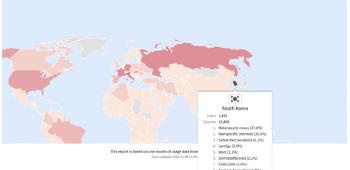An extra-lung tuberculosis warning throughout the body, not the lungs...Infections to the brain and bones
May 21, 2025
|
Mycobacterium tuberculosis can enter the body through the respiratory or digestive mucosa and spread throughout the body along blood and lymphatic vessels. It can cause infection in various organs such as lymph nodes, pleura, abdominal organs, bones, brain and spinal cord, not lungs, and in all of these cases, it is called extrapulmonary tuberculosis.
According to Professor Han Jae-joon of the Department of Infectious Diseases at Soonchunhyang University Bucheon Hospital '2024 Annual Report on Tuberculosis Patients', the number of extrapulmonary tuberculosis patients has been decreasing over the past three years (2022-2024). However, extrapulmonary tuberculosis is difficult to diagnose due to varying symptoms depending on the site of infection, and the actual number of patients is likely to be higher due to low reporting rates." The actual number of extrapulmonary tuberculosis patients is about 20% of all tuberculosis patients.
In the past, it was believed that a lot of extrapulmonary tuberculosis was present in patients with decreased immune functions such as hemodialysis, long-term steroid administration, and cirrhosis. However, a recent study found that about 60% of patients with extrapulmonary tuberculosis had no underlying disease.
Extrapulmonary tuberculosis has various symptoms depending on the site of infection. Local symptoms such as pain, swelling, and exercise restrictions are common, and systemic symptoms such as fever, helplessness, loss of appetite, weight loss, and sweating can be accompanied. However, in the early stages, diagnosis is often delayed because it is easy to be mistaken for other diseases. In this case, it is important to check whether there is a cause of repeated exposure to tuberculosis bacteria or whether there is contact with tuberculosis patients.
To diagnose extrapulmonary tuberculosis, a body fluid or tissue culture test at the suspected site of infection is performed, and tuberculosis bacteria are identified. However, the number of tuberculosis bacteria in the body is often relatively small, so about 40 to 70% of tuberculosis bacteria are confirmed by culture tests. Therefore, diagnosis requires abundant experience and clinical judgment.
For extrapulmonary tuberculosis, the standard treatment of taking anti-tuberculosis drugs for 6 months is generally applied. Periodic blood tests and follow-up observations are needed to check for drug side effects during treatment, and resistance before treatment should be determined.
Professor Han Jae-jun said "Many may misunderstand that extrapulmonary tuberculosis is also transmitted, but extrapulmonary tuberculosis without pulmonary tuberculosis is rarely contagious and generally does not require isolation treatment"
"The risk of developing extrapulmonary tuberculosis may increase even if immunosuppressants are recently taken for rheumatoid arthritis or Crohn's disease. If fever of unknown cause, weight loss, chronic pain or swelling in a specific area persists, it is important to seek medical treatment from the Department of Infectious Diseases and find out the cause early, he said.
|
This article was translated by Naver AI translator.















